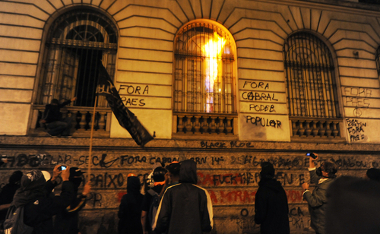THE Fourth Crusade (1202-1204) or “Venice Crusade” resulted in the sacking and seizure of the city of Constantinople (present-day Istanbul) and the establishment of the Empire Latin, leading the Christian world at the time to have three empires: in addition to the Latin, the Holy Roman Empire and the Empire Byzantine. Despite having only lasted half a century, the Latin Empire of Constantinople, commanded by Venice, contributed to the resurgence of trade between West and East.
The initial aim of the crusade was to try to retake the city of Jerusalem. However, the Venetian merchants, led by Dodge Enrique Dandalo, who were financing this crusade, intended to divert the expedition's route. Pressure on the ship's commanders made the crusade's target the city of Constantinople. With this diversion, the Venetians intended to attack the main commercial port of the Mediterranean Sea.
The first place taken by the Crusaders was the port of Zara, in the territory of present-day Croatia, dominated by the Hungarians. This location was a strategic point in the liberation of navigation in the Adriatic Sea. Then about 150 ships and galleys moved to the capital of the Byzantine Empire, taking the city by storm twice, in July 1203 and April 1204. After long and bloody battles, the Crusaders took the city and formed a parliament of 12 voters, who elected Baldwin, Count of Flanders, as the new monarch of Constantinople, being crowned in May 1204 in the Cathedral of St. Sophia, known as Hagia.
The Crusaders still inflicted heavy financial damage on the city, such as the heavy looting carried out in almost all of the temples in the rich Byzantine city. Gold, silver, precious jewels and other treasures were sent to Venice and traded in Europe. The religious relics were sent to Rome or even to other European cities. The display of these same relics guaranteed visits and pilgrimages, encouraging commerce in the cities that housed them.
Do not stop now... There's more after the advertising ;)
The conquest of Constantinople and the formation of the Latin Empire demonstrated that the aims of the crusades were not just religious. The initial objective being the withdrawal of Muslims from Jerusalem, why did Europeans invade and plunder a Christian empire like the Byzantine? Perhaps because the Latin Empire of Constantinople guaranteed the Venetians commercial control in the Mediterranean Sea. This situation also contributed to the European commercial renaissance in the 12th and 13th centuries and the consequent disintegration of the feudal world.
The city was retaken by the Byzantines in 1261, when Michael VIII Palaiologos overthrew Bedouin II, putting an end to the Latin Empire of Constantinople. But the marks of such an invasion were printed in the relationship between the Catholic Churches of the West and the East, which had separated in 1054, in the known schism of the east. The resentments generated by the invasion of Constantinople and the looting of countless Byzantine religious relics would not be eased until almost 800 years later. In 2004, Pope John Paul II returned the relics of the martyrs of the Orthodox Christian Church, which were stolen from the Church of St. Sophia, to the Orthodox ecumenical patriarch.
* Image Credit: muharremz and Shutterstock.com
By Tales Pinto
Graduated in History
Would you like to reference this text in a school or academic work? Look:
PINTO, Tales of the Saints. "Fourth Crusade and the Conquest of Constantinople"; Brazil School. Available in: https://brasilescola.uol.com.br/historiag/quarta-cruzada-conquista-constantinopla.htm. Accessed on June 27, 2021.


